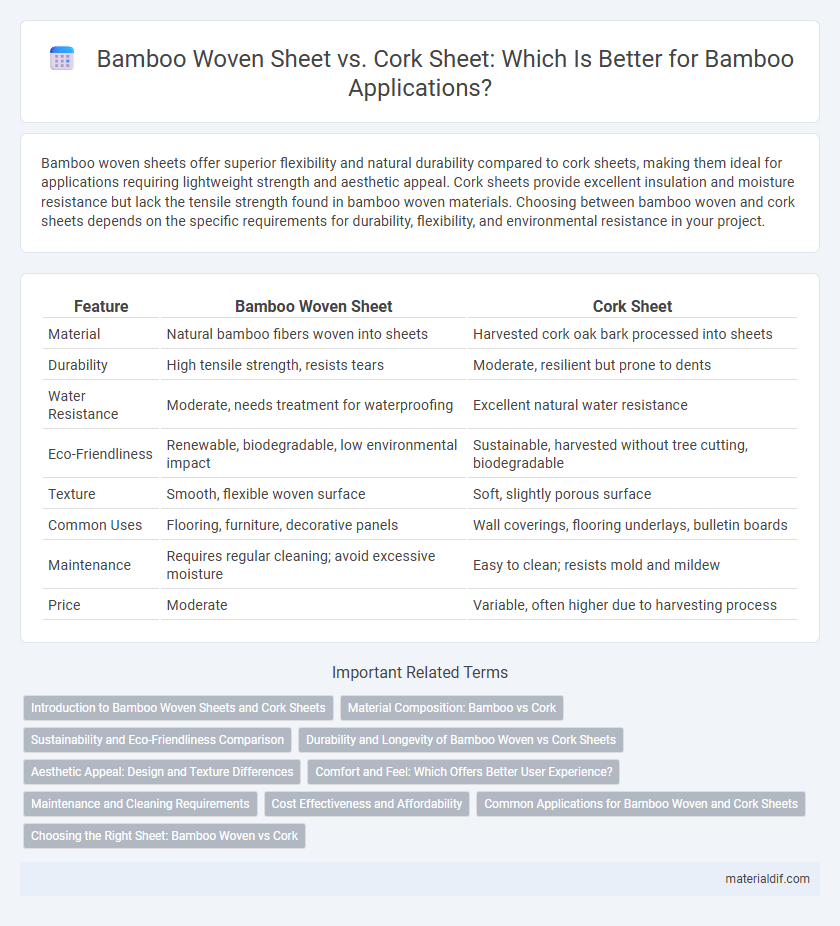Bamboo woven sheets offer superior flexibility and natural durability compared to cork sheets, making them ideal for applications requiring lightweight strength and aesthetic appeal. Cork sheets provide excellent insulation and moisture resistance but lack the tensile strength found in bamboo woven materials. Choosing between bamboo woven and cork sheets depends on the specific requirements for durability, flexibility, and environmental resistance in your project.
Table of Comparison
| Feature | Bamboo Woven Sheet | Cork Sheet |
|---|---|---|
| Material | Natural bamboo fibers woven into sheets | Harvested cork oak bark processed into sheets |
| Durability | High tensile strength, resists tears | Moderate, resilient but prone to dents |
| Water Resistance | Moderate, needs treatment for waterproofing | Excellent natural water resistance |
| Eco-Friendliness | Renewable, biodegradable, low environmental impact | Sustainable, harvested without tree cutting, biodegradable |
| Texture | Smooth, flexible woven surface | Soft, slightly porous surface |
| Common Uses | Flooring, furniture, decorative panels | Wall coverings, flooring underlays, bulletin boards |
| Maintenance | Requires regular cleaning; avoid excessive moisture | Easy to clean; resists mold and mildew |
| Price | Moderate | Variable, often higher due to harvesting process |
Introduction to Bamboo Woven Sheets and Cork Sheets
Bamboo woven sheets are crafted from thin strips of bamboo fibers, offering a flexible, lightweight, and durable surface commonly used in flooring, furniture, and decorative applications. Cork sheets derive from the bark of cork oak trees, prized for their natural insulation, cushioning properties, and resistance to moisture and fire. Both materials provide eco-friendly alternatives with distinct textures and functional benefits ideal for sustainable design projects.
Material Composition: Bamboo vs Cork
Bamboo woven sheets consist of interlaced bamboo fibers, offering a natural, durable, and flexible material with a smooth texture ideal for various applications. Cork sheets are made from the bark of cork oak trees, featuring a lightweight, compressible structure with excellent insulation and moisture resistance properties. Comparing both, bamboo provides greater tensile strength and flexibility, while cork excels in cushioning and thermal insulation due to its cellular, porous composition.
Sustainability and Eco-Friendliness Comparison
Bamboo woven sheets offer superior sustainability due to rapid bamboo growth rates and renewable harvesting, significantly reducing deforestation compared to cork harvesting, which relies on slower-regenerating cork oak trees. Bamboo's cultivation requires less water and fewer pesticides, enhancing its eco-friendliness, while cork sheets benefit from natural bark harvesting that preserves the tree's life cycle and supports biodiversity. Both materials provide biodegradable alternatives to synthetic sheets, but bamboo's fast renewability and lower resource demands position it as a more environmentally efficient choice in sustainable material manufacturing.
Durability and Longevity of Bamboo Woven vs Cork Sheets
Bamboo woven sheets exhibit superior durability and longevity compared to cork sheets, thanks to bamboo's natural fiber strength and flexibility. Bamboo's dense fibers resist wear, moisture, and deformation over time, maintaining structural integrity in high-use applications. In contrast, cork sheets, while lightweight and eco-friendly, tend to compress and degrade faster under sustained pressure and environmental exposure.
Aesthetic Appeal: Design and Texture Differences
Bamboo woven sheets offer a natural, organic texture with intricate patterns that create a warm, rustic aesthetic ideal for eco-friendly interior designs. In contrast, cork sheets feature a smooth, uniform surface with subtle granularity, providing a modern, minimalist look that enhances contemporary spaces. Both materials deliver unique visual and tactile experiences, but bamboo's woven complexity adds depth and artisanal charm unmatched by cork's simpler finish.
Comfort and Feel: Which Offers Better User Experience?
Bamboo woven sheets provide a breathable, soft texture that enhances comfort by naturally regulating temperature and moisture, making them ideal for sensitive skin. Cork sheets offer a firmer, more resilient feel with antimicrobial properties, but they lack the supple softness found in bamboo. Users seeking a cozy, smooth touch typically prefer bamboo woven sheets for superior comfort and a more pleasant tactile experience.
Maintenance and Cleaning Requirements
Bamboo woven sheets require regular dusting and occasional spot cleaning with a damp cloth to maintain their natural sheen and prevent mold buildup. Cork sheets are more resistant to moisture and stains, needing only periodic wiping with a mild soap solution, making them easier to maintain in humid environments. Both materials benefit from avoiding harsh chemicals and excessive water to preserve durability and longevity.
Cost Effectiveness and Affordability
Bamboo woven sheets offer superior cost effectiveness compared to cork sheets due to their lower production costs and renewable nature, making them more affordable for large-scale applications. Bamboo's rapid growth cycle and ease of harvesting significantly reduce raw material expenses, while cork extraction is labor-intensive and seasonal, leading to higher market prices. Choosing bamboo woven sheets provides a budget-friendly alternative without compromising durability or eco-friendliness.
Common Applications for Bamboo Woven and Cork Sheets
Bamboo woven sheets are commonly used in furniture making, wall coverings, and decorative panels due to their lightweight, flexibility, and natural texture. Cork sheets find frequent applications in flooring, bulletin boards, and insulation products because of their durability, compressibility, and thermal properties. Both materials are favored in eco-friendly construction and design, offering sustainable alternatives with distinctive aesthetic and functional benefits.
Choosing the Right Sheet: Bamboo Woven vs Cork
Bamboo woven sheets offer superior durability and natural antibacterial properties, making them ideal for eco-conscious consumers seeking long-lasting, hygienic materials. Cork sheets provide excellent cushioning, water resistance, and thermal insulation, suited for applications requiring softness and moisture control. Selecting between bamboo woven and cork sheets depends on prioritizing strength and breathability versus flexibility and insulation in your project.
Bamboo Woven Sheet vs Cork Sheet Infographic

 materialdif.com
materialdif.com